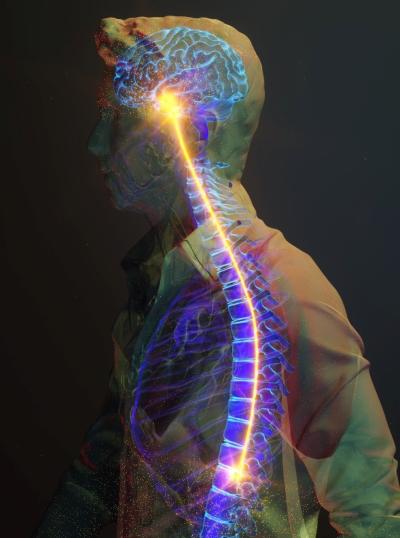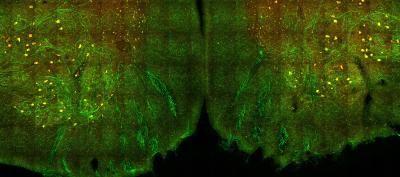New theory about the neural network that controls walking
Electrodes in turtles’ spinal cords produced surprising data – eventually spawning a theory about the existence of a previously unknown ‘command centre’ for movement.
Forskere fra Københavns universitet har via af række forsøg opdaget at den neurale aktivitet i rygmarven er anderledes end tidligere troet. Det kan bedst beskrives som en rotation mellem de forskellige nerveceller. Her ses en illustration af kommunikationen mellem hjerne og rygmarv. Netværk af neuroner i rygmarven producerer detailer i bevægelsen, som rytmen og koordinering af forskellige muskler, og hjerne giver besked om små korrektioner i bevægelsen samt hvornår bevægelsen startes og stoppes.
Four researchers from the Department of Neuroscience at the University of Copenhagen (UCPH) looked carefully at the results. Then they looked again – and again — without quite knowing what to say or think.
Something, in some undefinable way, was different about the data. The head of the team, Associate Professor Rune W. Berg, recalls: ‘Whatever they were, the results were nothing like prevailing theory said they ought to be.’

That was back in 2015. Only now, after seven years of mulling over the initial experiments, in which supersensitive electrodes monitored how turtles walk, has the team offered an explanation for the unexpected results.
The scientists at UCPH have just published an article in Nature, one of the world’s most renowned scientific journals.
The article is about the act of walking in general – in other words, repeatedly putting one leg in front of the other until you reach your destination.
More specifically, it is about the neural activity in the spinal cord that is thought to make walking possible and control it. It is here that the team brings completely new ideas to the table, which inevitably represent a challenge to the prevailing orthodoxy.
For decades, it has been thought that neural activity in the spinal cord “alternates”. In simple terms, the assumption is that networks of nerve cells in the spinal cord work along with certain areas of the brain to make walking possible by alternately activating particular muscles on the right and left sides of the body. But we did not know what these networks looked like in detail or how they are organised and function inside the spinal cord.
When the UCPH team studied microscopic recordings of turtles’ spinal cords as they walked, they found no evidence of this alternating neural activity. Nor did they find any evidence of it in similar experiments on rats and cats. Berg, the recipient of a Lundbeck Foundation Ascending Investigator grant, explains.
‘When we finally spotted it, what we saw were nerve cells constantly working together in network-like structures. The neural activity consisted of rhythmic movements that were repeated in all our experiments and are perhaps best described as “a continuous rotation”. That is nothing like the commonly held view of how neural networks in the spinal cord of vertebrates — including humans — make walking possible. That said, there’s still a lot we don’t know about these rotating networks and how they work,’ he points out.
A new ‘command centre’
But does it really matter whether neural networks in the spinal cord move one way or the other, just as long as they enable the vertebrate in question to walk?
Berg is unequivocal: ‘Yes, it matters – and that’s why alternative explanations like ours need to be studied in greater depth. We’ll do that, of course, but we hope other scientists will take up the challenge, too. Ultimately, it is about trying to better understand the “command centre” behind walking and a range of other movements,’ he explains and continues:
‘The standard theory is that the spinal cord more or less controls walking like a kind of circuit breaker or on-off switch. But in that case, the pattern should show up in experiments like the ones we conducted on animals. It didn’t,’ according to Berg:
‘Plus, humans and other vertebrates don’t just use their legs to walk. They are used for a wide range of other movements – some of which don’t involve alternating – like kicking or hopping. So, how should we understand the “command centre” for those types of movements?’
The UCPH scientists do not have a definitive answer. But they do have a theory – they suggest that the spinal cord’s neural network can be seen as the ‘command centre’ for vertebrates walking. The theory certainly makes sense in relation to the rotational activity in the networks that the team observed in the turtle experiments. But according to Berg, something else also supports the theory:
‘When we analysed the results, we also saw signs indicating that the individual nerve cells in the networks are part of a kind of dynamic communication system. They seem to exchange complex information and provide positive and negative feedback — encouraging or inhibiting activity.’
Berg says that the presence of this feedback-based communication system ‘now needs to be studied and hopefully substantiated’ via new experiments that will be designed and conducted by the UCPH team.
‘The theory that the neural network in the spinal cord acts as a “command centre” for walking in vertebrates fits neatly with the existence of a feedback-based communication system. And, if there is a complex communication system like that, it would be logical to assume that the spinal cord’s neural network can cope with many different tasks. It may be responsible not only for walking but potentially for controlling and enabling various other movements by vertebrates,’ explains Berg.

Treatment perspectives
The team has ordered new equipment, special electrodes that will measure, in real time, activity running in all directions between about 1,000 nerve cells in a spinal cord network. ‘This is going to generate a serious amount of data,’ says Berg.
It might sound tempting to implant these electrodes into human spinal cords, but that is not possible for a number of reasons. The team will instead use other vertebrates, including turtles and rats.
In scientific terms, this will provide a viable model for exploring the basic conditions for movement in humans. Berg explains that the next series of experiments will focus on rats:
‘Rats are really suitable for experiments like these. We want to test how animals’ nerve cells are activated — how they “switch on” – during completely natural behaviour and when our experiments trigger more unusual movements. Rats are good because they make many of the same movements as humans.’
The idea behind the new experiments is to build basic knowledge of how nerve cells in the spinal cord interact with the way that the brain controls movement activity — and to study, for example, whether there is a link between the location of nerve cells in the spinal cord and their function. Berg says:
‘New knowledge about how movements are controlled and what makes them possible might greatly improve our understanding of – and perhaps help us treat – conditions associated with spinal cord injuries. For example, damage to the spinal cord after blood clots and the effects of neurodegenerative disorders like ALS.’
The research team at UCPH behind the Nature article consists of Associate Professor Rune W. Berg; Assistant Professor Henrik A. Lindén; Postdoc and Lundbeck Foundation Fellow 2022 Peter C. Petersen; and Mikkel Vestergaard PhD.